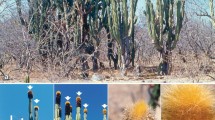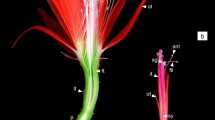Abstract
The morphology and anatomy of the Cephalocereus columna-trajani flowering region was described and compared with data on other species. The vegetative and reproductive regions were described in detail. The results showed that after the flowering region is differentiated, morphological changes take place which are correlated with anatomical changes. The flowering region in this species is termed a lateral cephalium because of its reduced interareolar space, increased areole size and abundant long bristles and trichomes in the areoles. Periderm development near the apical meristem, lack of chlorenchyma and a delay in xylem fiber differentiation are also traits characteristic of a lateral cephalium. The lateral cephalium of C. columna-trajani shared the same combination of morpho-anatomical characters with its sister taxon, C. senilis, except for the number of ribs in the cephalium. Both species survive in high temperature environments and their cephalium faces north; however, only C. columna-trajani tilts, thus we hypothesize that incorporation of fewer ribs associated with periderm development in the cephalium contributes to stem tilting.
Similar content being viewed by others
References
E. F. Anderson (2001) The Cactus family Timber Press Portland
S. Arias T. Terrazas K. M. Cameron (2003) ArticleTitlePhylogenetic analysis of Pachycereus (Cactaceae, Pachycereeae) based on chloroplast and nuclear DNA sequences Syst. Bot. 28 547–557
S. Arias T. Terrazas H. J. Arreola-Nava M. Vázquez-Sánchez K. M. Cameron (2005) ArticleTitlePhylogenetic relationships in Peniocereus (Cactaceae) inferred from plastid DNA sequence data J. Pl. Res. 118 317–328 Occurrence Handle10.1007/s10265-005-0225-3 Occurrence Handle1:CAS:528:DC%2BD2MXht1KnsbjN
C. Backeberg (1976) Cactus lexicon. Enumeratio diagnostica Cactacearum EditionNumber3 Blandford Press Dorset
W. Barthlott D. R. Hunt (1993) Cactaceae K. Kubitzki (Eds) The families and genera of vascular plants Springer Berlin 161–197
S. Bernal-Salazar T. Terrazas (2005) ArticleTitleWood anatomical variation of Neobuxbaumia tetetzo: a columnar Cactaceae J. Arid Environ. 63 671–685 Occurrence Handle10.1016/j.jaridenv.2005.04.006
H. Bravo-Hollis (1978) Las cactáceas de México. Vol. I Universidad Nacional Autónoma de México México, D.F
F. Buxbaum (1952) ArticleTitleMorphologie des “Spaltcephaliums” von Espostoa sericata Österr. Bot. Zeit. 99 89–99 Occurrence Handle10.1007/BF01288567
Buxbaum F. (1964a) Was ist ein Cephalium? Kakteen Sukku. 15: 28–31.
Buxbaum F. (1964b) Was ist ein Cephalium? Kakteen Sukku. 15: 43–48.
U. Eggli (1984) ArticleTitleStomatal types of Cactaceae Pl. Syst. Evol. 146 197–214 Occurrence Handle10.1007/BF00989546
A. C. Gibson K. E. Horak (1978) ArticleTitleSystematic anatomy and phylogeny of Mexican columnar cacti Ann. Missouri Bot. Gard. 65 999–1057 Occurrence Handle10.2307/2398781
A. C. Gibson P. S. Nobel (1986) The cactus primer Harvard University Press Cambridge
D. A. Johansen (1940) Plant microtechnique MacGraw Hill New York
S. Loza-Cornejo T. Terrazas (2003) ArticleTitleEpidermal and hypodermal characteristics in North American Cactoideae (Cactaceae) J. Pl. Res. 116 27–35
J. D. Mauseth (1989) ArticleTitleComparative structure-function studies within a strongly dimorphic plant, Melocactus intortus (Cactaceae) Bradleya 7 1–11
J. D. Mauseth (1999) ArticleTitleComparative anatomy of Espostoa, Pseudoespostoa, Thrixanthocereus, and Vatricania (Cactaceae) Bradleya 17 33–43
J. D. Mauseth R. G. Ross (1988) ArticleTitleSystematic anatomy of the primitive ceroid cactus Leptocereus quadricostatus Bradleya 6 49–64
Media Cybernetics (1997) Image pro-plus, version 3.0 for Windows. Media Cybernetics Inc. Silver Spring, MD.
W. Rauh (1979) Kakteen an ihren Standorten Verlag Paul Parey Berlin-Hamburg
N. P. Taylor D. C. Zappi (1989) ArticleTitleAn alternative view of generic delimitation and relationships in tribe Cereeae (Cactaceae) Bradleya 7 13–40
T. Terrazas S. Arias (1999) Las ramas dimórficas de la tribu Pachycereeae (Cactaceae) M. A. Vásquez (Eds) Resúmenes del II Congreso Mexicano y I Congreso Latinoamericano y del Caribe de cactáceas y otras plantas suculentas Sociedad Mexicana de Cactología Oaxaca 89
T. Terrazas S. Arias (2002) ArticleTitleComparative stem anatomy in the subfamily Cactoideae Bot. Rev. 68 444–473 Occurrence Handle10.1663/0006-8101(2002)068[0444:CSAITS]2.0.CO;2
T. Terrazas L. Loza-Cornejo (2002) Phylogenetic relationships of Pachycereeae: a cladistic analysis based on anatomical-morphological data T. H. Fleming A. Valiente-Banuet (Eds) Evolution, ecology and conservation of the columnar cacti and their mutualists Arizona University Press Tucson 66–86
T. Terrazas D. J. Mauseth (2002) Shoot anatomy and morphology P. Nobel (Eds) Cacti: Biology and uses California University Press Berkeley 23–40
C. Tinoco-Ojanguren F. Molina-Freaner (2000) ArticleTitleFlower orientation in Pachycereus pringlei Canad. J. Bot. 78 1489–1494 Occurrence Handle10.1139/cjb-78-12-1489
Vázquez–Sánchez M. (2002) El cefalio de Pachycereus militaris. Tesis de Licenciatura. FESIztacala, Universidad Nacional Autónoma de México, Tlalnepantla.
M. Vázquez–Sánchez T. Terrazas S. Arias (2005) ArticleTitleMorfología y anatomía del cefalio de Cephalocereus senilis (Cactaceae) Anales Jard. Bot. Madrid 62 153–161
F. Vite-González P. L. Valverde-Padilla M. A. Pérez-Hernández J. A. Zavala-Hurtado (2004) Variación geográfica de la orientación del pseudocefalio en Cephalocereus columna-trajani. I V. Sosa (Eds) Resúmenes del XVI Congreso Mexicano de Botánica Sociedad Botánica de México Oaxaca 57
J. A. Zavala-Hurtado F. Vite E. Ezcurra (1998) ArticleTitleStem tilting and pseudocephalium in Cephalocereus columna-trajani (Cactaceae): a functional interpretation Ecology 79 340–438 Occurrence Handle10.2307/176887
Author information
Authors and Affiliations
Corresponding author
Rights and permissions
About this article
Cite this article
Vázquez-Sánchez, M., Terrazas, T. & Arias, S. Morphology and anatomy of the Cephalocereus columna-trajani cephalium: why tilting?. Plant Syst. Evol. 265, 87–99 (2007). https://doi.org/10.1007/s00606-007-0520-7
Received:
Accepted:
Published:
Issue Date:
DOI: https://doi.org/10.1007/s00606-007-0520-7




